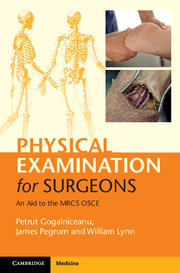Book contents
- Frontmatter
- Dedication
- Contents
- List of contributors
- Introduction
- Acknowledgments
- List of abbreviations
- Section 1 Principles of surgery
- Section 2 General surgery
- Section 3 Breast surgery
- Section 4 Pelvis and perineum
- Section 5 Orthopaedic surgery
- Section 6 Vascular surgery
- Section 7 Heart and thorax
- Section 8 Head and neck surgery
- Section 9 Neurosurgery
- Section 10 Plastic surgery
- Section 11 Surgical radiology
- Section 12 Airway, trauma and critical care
- 63 Examination of the trauma patient
- 64 Examination of the critically ill surgical patient
- 65 Assessment of the airway for intubation
- 66 Assessment of the compromised airway
- 67 Examination of a tracheostomy
- Index
65 - Assessment of the airway for intubation
from Section 12 - Airway, trauma and critical care
Published online by Cambridge University Press: 05 July 2015
- Frontmatter
- Dedication
- Contents
- List of contributors
- Introduction
- Acknowledgments
- List of abbreviations
- Section 1 Principles of surgery
- Section 2 General surgery
- Section 3 Breast surgery
- Section 4 Pelvis and perineum
- Section 5 Orthopaedic surgery
- Section 6 Vascular surgery
- Section 7 Heart and thorax
- Section 8 Head and neck surgery
- Section 9 Neurosurgery
- Section 10 Plastic surgery
- Section 11 Surgical radiology
- Section 12 Airway, trauma and critical care
- 63 Examination of the trauma patient
- 64 Examination of the critically ill surgical patient
- 65 Assessment of the airway for intubation
- 66 Assessment of the compromised airway
- 67 Examination of a tracheostomy
- Index
Summary
Checklist
WIPER
• Patient sitting at examiner's eye level
Physiological parameters
Look
• General : obese, pregnant, beard present, posture
• Jaw : receding mandible, mouth opening
• Oral cavity : swelling, vomit, tumour, infection, burns
• Teeth : prominent, loose
• Face : syndromes, acromegaly
• Neck : cervical spine immobility, scarring, masses
Feel
• Neck : masses
Move
• Neck : flexion/extension
• Jaw : opening
Special tests
• Mallampati score
• Wilson's score
• Interdental distance
• Thyromental distance
• Atlanto-occipital movement
• Mandibular protrusion
Examination notes
What is the OBESE mnemonic for predicting a difficult airway?
O Obese
B Bearded
E Elderly (> 55 years old)
S Snorers (suggesting sleep apnoea; syndromes pose additional difficulties)
E Edentulous (no teeth)
What syndromes pose airway difficulties?
• Down's syndrome can indicate cervical instability and potential contraindication to neck hyperextension during intubation.
• Pierre–Robin and Treacher–Collins syndromes are associated with micrognathia, making direct laryngoscopy difficult.
What specific features do you look for in the examination of the airway?
• Asking the patient to open the mouth as wide as possible assesses the degree of mouth opening and also allows inspection of the mouth.
• Loose or prominent teeth should be assessed; these can obscure the view at laryngoscopy or even be dislodged and cause airway obstruction during intubation.
• Patients with acromegaly will have a large tongue and jaw. Large tongues are difficult to depress out of view and impair the visualisation of the glottis in direct laryngoscopy.
• Scarring of the neck can indicate previous trauma or radiotherapy. Both of these can mean tethering of internal airway structures and rigidity leading to poor views at laryngoscopy.
How is movement of the neck assessed?
Ask the patient to maximally extend the neck, and estimate the angle that the upper teeth have moved through from the neutral to the maximally extended position. Movement of less than 20° is associated with difficult intubation.
- Type
- Chapter
- Information
- Physical Examination for SurgeonsAn Aid to the MRCS OSCE, pp. 491 - 493Publisher: Cambridge University PressPrint publication year: 2015



